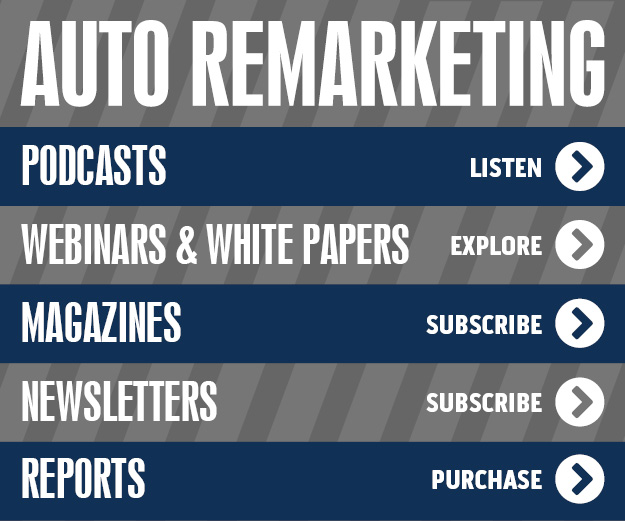GWC Warranty acknowledged vehicle shoppers are looking for a bargain, and dealers are looking to turn a profit, meaning those two worlds collide during the art of negotiation.
As experienced negotiators, GWC Warranty pointed out every sales and F&I professional has techniques that have worked for years. But as customers evolve, the company insisted that so must negotiation skills.
In light of that backdrop, GWC Warranty offered three suggestions in a recent company blog post that can lead to a positive result for both stores and their customers.
1. Honesty is the best policy, and so is transparency
GWC Warranty emphasized today’s customers are more informed than ever.
“In being completely transparent about every line item they’re paying for, you’re converting their experience from one of resistance to one of receptiveness,” company experts said. “In doing so, customers will be more likely to let their guard down and see value in F&I products rather than defaulting to raising an objection.”
2. Have an open mind, and don’t fear change
GWC Warranty insisted the best businesses are the ones that can evolve to meet the needs of their customers.
The company recommended that dealerships consider changes managers can make — both large and small — to the way they negotiate with customers.
“It could start small with your employees and removing words with negative connotations from your daily vocabulary — things like ‘close’ or ‘sell.’ Or it could be changes to the way you present your menu that give customers an option rather than forcing them to fight for the products they want at a price they feel is fair — which leads us to the final piece of advice,” company experts said.
3. Prioritize price
As GWC Warranty previously mentioned, customers are more informed than ever.
“They’ve shopped long and hard for the car they want,” experts said. “While price is often the focus of a negotiation, vehicle make and model, selected options and other features are proven to be higher priorities than price for customers.”
If a buyer has made it to the F&I office, GWC Warranty pointed out they’ve already picked the vehicle they want.
“Be willing to work toward making F&I products work for both of you, but know that your customer is already comfortable with the purchase,” experts said.
“The time in the F&I office is best served ensuring your customer can drive that vehicle confidently for many miles to come — not haggling on price or a laundry list of products that don't fit their personal situation.
Editor’s note: This post and more best-practice recommendations can be found at gwcwarranty.com/dealers/accelerate-blog.
With used-vehicle financing leading the charge, Experian’s latest State of the Automotive Finance Market report showed finance companies booked significantly more contracts with super-prime customers during the second quarter than they did with deep subprime consumers.
Creating what analysts called steady growth and remarkable stability quarter-over-quarter, the second-quarter report released on Tuesday indicated that auto finance companies made more than five times as many loans to super-prime customers (17.9 percent of total auto loans and leases) as to deep-subprime customers (3.5 percent of total auto loans and leases).
That influx of higher-grade paper meant the combined subprime and deep-subprime share of new- and used-vehicle loans and leases dropped from 23.3 percent in Q2 2015 to 22.8 percent in Q2 2016, according to Melinda Zabritski, senior director of automotive finance for Experian.
“Automotive lenders seem to be keeping cool heads when it comes to how much risk they are willing to take with subprime and deep-subprime customers,” said Zabritski, who is coming back to the SubPrime Forum at Used Car Week for the fourth consecutive year to share more data and trends.
“Yes, subprime and deep-subprime loans are growing, but the entire market is growing from a volume perspective across all risk tiers,” she continued. “In fact, the subprime loans have actually dropped as a percentage of the total market. That, combined with only a slight uptick in delinquencies, makes clear that the sky is not falling.”
Experian determined 30-day delinquencies inched up just 3 basis points year-over-year from 2.19 percent in Q2 2015 to 2.22 percent in Q2 2016. Meanwhile, Experian found that 60-day delinquencies moved just 6 basis points higher from 0.56 percent to 0.62 percent in the same time period.
“Fear of an impending automotive subprime bubble has been swirling around the industry since the recovery from the Great Recession,” Experian said. “Those fears haven’t come to fruition.”
Overall, Experian reported that finance companies held $1.027 trillion in outstanding balances through the second quarter; that’s up from $932 billion a year earlier.
Each of the four major categories of providers that Experian designates posted year-over-year gains in outstanding balances. Those four categories include commercial banks (up by $27 billion), captives (up $13 billion), credit unions ($33 billion) and finance companies that do not hold deposits and often take on subprime risk (up $21 billion).
More used paper in portfolios
Experian highlighted used-vehicle loans grew to record heights in terms of average dollar amount and overall loan share during the second quarter.
The average used vehicle loan reached an all-time high of $19,101 in Q2, up from $18,671 in Q2 of last year.
Used-vehicle contract volume also reached a new peak, accounting for 55.61 percent of all vehicle loans during the second quarter.
Analysts noticed the growth was driven by jumps in prime and super-prime consumers choosing used vehicles. Specifically, 43.3 percent of super-prime consumers selected a used vehicle, which represents a 10 percent increase over 2015. For prime consumers, 59.9 percent chose used, a 6.6 percent increase over the previous year.
This shift also helped push the average credit score for a used vehicle loan from 645 in Q2 2015 to 648 in Q2 2016.
“One of the biggest trends we continue to see is the shift to used vehicles by customers with excellent credit,” said Zabritski, who will appear during the SubPrime Forum, which runs Nov. 14-16 at the Red Rock Resort and Casino in Las Vegas.
“As vehicle prices continue to rise, savvy consumers are looking for ways to control costs. That appears to be pushing more customers toward used vehicles,” she went on to say.
Other Q2 2016 findings:
• The average monthly payment for a used vehicle was $364, up from $361 in Q2 2015.
• The average monthly payment for a new vehicle loan was $499, up from $483 in Q2 2015.
• The average new vehicle loan amount was $29,880, up $1,356 from the Q2 2015 average new vehicle loan amount of $28,524.
• Average customer credit scores for new vehicle loans fell slightly, from 709 in Q2 2015 to 708.
• The average loan term for a new vehicle went from 67 months in Q2 2015 to 68 months.
CU Direct has reached a new milestone in auto loans, helping credit unions fund more than $16.1 billion in loans at the halfway point of the year.
A provider of technology and automotive solutions for the credit union industry, CU Direct has helped its more than 1,000 credit union partners increase funded installment contracts by 24.5 percent year-over-year.
Officials highlighted credit unions funded a record 529,000 contracts through CU Direct’s Lending 360 and CUDL platforms in the first half of 2016, a 16.4-percent increase above the mid-point of last year. As a result, CU Direct calculated that its credit union partners, as an aggregate, are the nation’s third-largest auto financer, experiencing higher loan origination growth than any auto lender ranked among the nation's top ten.
CU Direct insisted credit unions experienced greater loan growth than Wells Fargo Dealer Services and Ally Financial, according to AutoCount.
The growth reflects credit unions' continued appetite in auto financing, growing market share from 19.7 percent year-end 2014 to 21 percent in June of 2016.
“CU Direct is excited to help our partner credit unions increase auto lending scale and efficiency, improving overall market share and creating a better member experience,” CU Direct president and chief executive officer Tony Boutelle said.
“We are committed to delivering innovative technology, products and services that help credit unions make more loans and improve their members’ auto buying and auto lending experiences today and in the future,” Boutelle continued.
The National Automotive Finance Association and the American Financial Services Association on Thursday announced the availability and launch of the 2016 Non-Prime Automotive Finance Survey.
For 20 years the NAF Association has produced a report of the nonprime auto financing market. NAF Association leaders partnered with AFSA for the second year to conduct the broadest survey of the non-prime auto-financing marketplace. Through the combined efforts of both associations, 50 companies contributed to the survey to produce the most comprehensive study of the industry ever compiled.
“More and more companies are relying on the survey as a benchmarking tool to measure their company’s performance and to identify industry trends,” NAF Association executive director Jack Tracey said. “The metrics can also be useful in explaining a company’s policy decisions to regulators.
“This broad base of contributing finance company data provides an accurate and unbiased view of the industry,” continued Tracey, who again will be part of the SubPrime Forum during Used Car Week on Nov. 14-16 at the Red Rock Resort and Casino in Las Vegas.
The increased participation in the 2016 Non-Prime Survey represents an outstanding principal exceeding $34 billion (year end 2015).
Below is an example of the key market trends, performance evaluations, statistical analysis, comparison and benchmarking included in survey:
• Market growth
• Competition
• Market share
• Dealerships network
• Risk indicators
• Credit scores
• Payment to income ratios
• Average loan rates
• Delinquency
• Repossession rate
• Net charge-off rate
• Average amount financed
• Contract terms
• Operating expenses
• Profitability
The survey is being distributed at no cost to NAF Association and AFSA member companies that participated. For other companies interested in the survey, the cost is $500 and it can be ordered online here.
While delinquencies posted a “slight increase” during the second quarter, Jason Laky, senior vice president and automotive and consumer lending business leader for TransUnion, pinpointed the two drivers that brought more than 5 million additional consumers into the auto finance market in Q2.
According to TransUnion’s latest Industry Insights Report released on Tuesday, the number of consumers with an auto loan increased 7 percent from 72.87 million in Q2 2015 to 77.95 million in Q2 2016. During a phone conversation with SubPrime Auto Finance News, Laky pointed out what is bringing those new accounts into portfolios.
“One is we still have strong economic fundamentals,” Laky said. “Consumers are continuing to get new jobs and so the employment rolls are growing. People are getting raises so their wages and salaries are increasing year-over-year. People have the confidence to get a new car. If they haven’t worked for a while, and you just got yourself a new job, a lot of people take that occasion to get themselves newer transportation.
“The second thing is we’re still in a very good rate environment,” he continued. “Lenders are offering strong rates and even some really good lease deals. Many consumers are also choosing to finance their new-car purchase or lease their new-car purchase just because it’s a very low cost of funds to do so. People who might otherwise pay cash are choosing to finance.
In Q2, TransUnion indicated the average auto loan balance per consumer grew 2.7 percent and reached $18,177, the highest level post-recession. The average balance was up from $17,699 in Q2 of last year.
“Competition is still strong,” Laky said. “Over the past five years, as we’ve come out of the recession, there has been a return of credit unions. We’ve seen credit unions get big again in auto lending, particularly on the prime side.
“On the non-prime side, we’ve seen again some growth in confidence among the independent lenders, the ones who focus on non-prime and subprime consumers,” he continued. “When subvented financing and good lease programs are in place, captive finance companies are in play, as well.
“It’s a good market where the rising tide is lifting boats for everyone,” Laky added.
Viewed one quarter in arrears to ensure all accounts are reported and included in the data, TransUnion determined auto loan originations grew 6.4 percent year-over-year in the first quarter of 2016. Auto originations reached their highest post-recession level at 6.93 million in Q1 2016, up from 6.51 million in Q1 2015.
With so much paper in portfolios nowadays, TransUnion turned its attention to the auto delinquency rate connected to contracts 60 or more days past due.
Analysts found that in Q2 of this year the auto delinquency rate increased to 1.11 percent, an 11-basis point rise from 1.00 percent in Q2 of last year.
“While delinquency rates rose in the second quarter, auto delinquency has been at all-time lows. We do not see a cause for concern from this slight increase,” Laky said.
“It still remains a good loan to make as you’ve seen in the delinquency side,” he continued about auto financing. “That means as more lenders are competing for every loan, the buy rates face a lot of pressure.
“What lenders are doing — the ones I think are successful in the marketplace at achieving continued growth in a high-competition environment — they’re looking for new ways to segment risk using alternative data or trended data that TransUnion has and others to better understand the risk of that particular consumer so they can carve out places where they believe that the consumer — be them subprime or prime — is going to perform better than a standard scoring model applicant,” Laky went on to say.
“When lenders can find those consumers, they can confidently compete for those loans and know they’re going to be profitable,” he added.
For more details about other segments of the credit market, TransUnion’s Q2 2016 Industry Insights Report can be reviewed here.
With technology leveling the playing field to a degree, relationships nowadays really matter, especially when they involve how a dealer is going to get a delivery bought for their customers or how they’re going to have the floor planning for inventory.
The J.D. Power 2016 U.S. Dealer Financing Satisfaction Study determined the relationships auto finance providers develop with dealerships are critical to dealer satisfaction and to remaining competitive in the market, especially as the new-vehicle sales market tightens.
J.D. Power insisted a combination of “slowing” new-vehicle sales and an “uncertain” used-vehicle market is contributing to an already contested auto-lending environment. Analysts acknowledged technology has eliminated disparity of speed in financing, leaving finance companies to differentiate themselves by the relationship they are able to form with the dealership.
“Speed has been king and the area lenders have traditionally focused on, but as the market gets tougher, lenders need to center their attention on their relationships with dealers, or they are going to lose business," said Jim Houston, senior director of the automotive finance practice at J.D. Power.
“Lenders need to move beyond a transactional relationship with dealers to a richer consultative partnership,” Houston continued. “Lenders with a dealer-centric culture across their organization — not just in various pockets of the business — are the ones that are most likely to excel.”
Houston noted that in building a dealer-centric culture, finance companies must understand their dealers’ businesses and goals, which helps establish them in the eyes of dealers as their business partner and problem solver. That starts with communication with the dealer.
The study indicated that fewer than half of dealers receive consistent sales rep calls or visits, both of which can boost overall satisfaction by as much as 68 points and 75 points, respectively, on a 1,000-point scale. But it's more than just the frequency of the contact, it's the nature of those touch points that adds value to the relationship.
"Dealers value a lender that can help them handle the tough issues and solve those 'outside-the-box' situations,” Houston said. “This is where having the right people focused on their dealers and helping them execute their strategic plan is essential."
Opportunities to excel and grow business
The study identified three areas of opportunity for finance companies that will help them enhance their dealer relationships. They included:
1. Consistent performance among their dealer relationship managers
2. Identification of their best dealers and a prioritization of those relationships
3. Efforts that focus on areas most important to dealers
“These are the things dealers say they want from their lenders, but are not necessarily getting on a consistent basis,” Houston said. “When the market gets tough, lenders that meet dealer expectations are going to get a greater share of the business.”
Findings of the study showed that high satisfaction with finance companies leads dealers to increase the amount of business they send to those respective lenders over the next year. Falloff is swift when satisfaction declines.
When satisfaction scores are 900 points or higher, J.D. Power found 62 percent of dealers say they are likely to increase the amount of business they send to the lender over the next year.
When satisfaction falls to between 800 and 889, J.D. Power noticed only 37 percent of dealers indicate they intend to send more business to that finance company.
When satisfaction dips to 700-799, J.D. Power said only 22 percent of dealers intend to increase business with that finance company.
Analysts mentioned two other key findings from the study, which included:
—Speed still matters: Speed still plays a significant role when dealers are choosing lending partners.
When finance companies fund error-free contracts on the same day as they are submitted, dealer satisfaction increases by as much as 64 points.
When finance companies notify dealers of contract issues or errors within four hours after they are submitted, satisfaction increases by as much as 60 points.
—Exceptions to the rule: Dealers want their lending partners to value the total relationship. In some cases, this means providing exceptions when warranted.
A well-managed exception process can increase overall satisfaction by up to 79 points.
Dealer financing satisfaction rankings
German luxury brand captives dominated the dealer rankings.
Mercedes-Benz Financial Services ranked highest among lenders in the prime retail credit segment for a second consecutive year with a score of 961. Following in the rankings were BMW Financial Services (959), Alphera Financial Services (941), Lincoln Automotive Financial Services (936) and Infiniti Financial Services (930).
Mercedes-Benz Financial Services also ranked highest among finance companies in the retail leasing segment for a second consecutive year with a score of 982. Following in the rankings were BMW Financial Services (958), Ford Credit (913), Volvo Car Financial Services (912) and Subaru Motors Finance (911).
And making it a sweep for the captive, Mercedes-Benz Financial Services ranked highest among floor planning providers for a sixth consecutive year with a score of 986. Following in the rankings were BMW Financial Services (975), Huntington National Bank (969), Hyundai Motor Finance (945) and Kia Motors Finance (945).
J.D. Power explained satisfaction is measured across three factors in the prime and non-prime retail credit segments: finance provider offerings, application and approval process, and sales representative relationship.
Four factors are measured in the retail leasing segment: finance provider offerings, application and approval process, sales representative relationship and vehicle return process.
Four factors are measured in the floor planning segment: finance provider credit line, floor plan support, sales representative relationship, and floor plan portfolio management.
The 2016 U.S. Dealer Financing Satisfaction Study captures more than 20,000 finance provider evaluations across the four segments. These evaluations were provided by 3,100 new-vehicle dealerships in the United States. More details can be found here.
Prime retail credit overall customer satisfaction index scores, based on a 1,000-point scale:
Mercedes-Benz Financial Services: 961
BMW Financial Services: 959
Alphera Financial Services: 941
Lincoln Automotive Financial Services: 936
Infiniti Financial Services: 930
Subaru Motors Finance: 908
Jaguar Financial Group: 902
Chase Automotive Finance: 895
Land Rover Financial Group: 891
Huntington National Bank: 890
Volvo Car Financial Services: 890
Ford Credit: 888
NMAC: 884
BB&T: 881
Citizens One: 875
TD Auto Finance: 874
Ally Financial: 873
Mazda Capital Services: 873
Volkswagen Credit: 873
Industry Average: 868
Capital One Auto Finance: 867
Fifth Third Bank: 867
Bank of America: 866
SunTrust Bank: 864
Toyota Financial Services: 860
Kia Motors Finance: 859
Wells Fargo Dealer Services: 853
PNC Bank: 851
BMO Harris Bank: 844
US Bank: 835
Bank of The West: 822
Hyundai Motor Finance: 821
GM Financial: 815
Credit Union Direct Lending: 813
Honda Financial Services: 813
Chrysler Capital: 798
Note: Included in the study but not ranked due to small sample size are Acura Financial Services, Alaska USA Federal Credit Union, Fidelity Bank, First Niagara Bank, Gateway One Lending & Finance, MINI Financial Services, Santander Auto Finance and Security Service Federal CU.
Retail leasing overall customer satisfaction index scores, based on a 1,000-point scale:
Mercedes-Benz Financial Services: 982
BMW Financial Services: 958
Ford Credit: 913
Volvo Car Financial Services: 912
Subaru Motors Finance: 911
Land Rover Financial Group: 891
NMAC: 891
Jaguar Financial Group: 890
Mazda Capital Services: 886
Industry Average: 885
Toyota Financial Services: 869
Kia Motors Finance: 868
Honda Financial Services: 866
US Bank: 863
Ally Financial: 851
GM Financial: 843
Hyundai Motor Finance: 835
Chrysler Capital: 828
Note: Included in the study but not ranked due to small sample size are Infiniti Financial Services, Lincoln Automotive Financial Services, MINI Financial Services and Volkswagen Credit.
Floor planning overall customer satisfaction index scores, based on a 1,000-point scale:
Mercedes-Benz Financial Services: 986
BMW Financial Services: 975
Huntington National Bank: 969
Hyundai Motor Finance: 945
Kia Motors Finance: 945
Ford Credit: 944
Chase Automotive Finance: 941
Industry Average: 938
Ally Financial: 935
NMAC: 931
Bank of America: 927
GM Financial: 926
Toyota Financial Services: 899
Chrysler Capital: 897
Note: Included in the study but not ranked due to small sample size are PNC Bank, Volkswagen Credit and Wells Fargo Dealer Services.
Credit Acceptance chief executive officer Brett Roberts approached the topic of competition from three different angles when the subprime auto finance company took questions from investment analysts who wanted more details about its second-quarter performance, which included a year-over-year rise of more than $10 million in consolidated net income.
The first way Roberts described how Credit Acceptance is tackling competition stemmed from how the finance company watched its active dealer network jump by 18 percent to 7,181 stores that originate at least one deal during a quarter. However, active volume per dealer softened by nearly 2 percent, a trend Credit Acceptance has seen previously.
“I think from an environment standpoint, it's pretty much consistent with what we would have said last quarter,” Roberts said. “Volume per dealer is probably the easiest number to look at just to get a sense for the competitive environment. It was down this quarter, not down a lot but 1.8 percent.
“So looking at that number I don't think you can conclude the environment got a lot easier, so I would probably say more of the same: a difficult environment but not changing a lot from last quarter,” he continued.
When the Wall Street observer immediately asked whether an active dealer base above 7,000 should be Credit Acceptance’s “new normal,” Roberts added, “We had nice growth in active dealers but yes, sequentially second quarter tends to be a little bit tougher of a quarter to grow, but I think you’re right that having a sequential decline isn't something that has happened in a long time.
“Attrition was higher this quarter and again, we’d probably attribute that to the competitive environment,” he went on to say.
The attrition Roberts mentioned came in at a decline of 17.2 percent in Q2. In the year-ago period, it was 13.9 percent. Credit Acceptance explained that attrition is measured according to the following formula: Decrease in consumer loan unit volume from dealers who have received funding for at least one dealer loan or purchased loan during the comparable period of the prior year but did not receive funding for any dealer loans or purchased loans during the current period divided by prior year comparable period consumer loan unit volume.
Later in the call, the competitive environment Credit Acceptance is facing was approached from another perspective: whether the finance company would have to price a little “more aggressively,” and if Q2 levels for average term and advance rate would be a good benchmark. Credit Acceptance’s average term for contracts originated in Q2 was 53.2 months, up from 51.3 months a year earlier. Meanwhile the finance company’s advance rate was 44 percent in Q2.
To answer that question after Credit Acceptance originated 76,520 installment contracts in Q2, Roberts said, “We look at pricing. We look at loan performance. We look at where our volume is coming from every quarter or every month, and we make changes where we see opportunities. There was a change in the mix of loans in the second quarter. We did more purchase loans, which tend to be larger, and then both within dealer and purchased loans we did a little bit larger loan, little bit longer term. Again, that’s just based on our pricing algorithms and where we think the best opportunities are.”
In yet another way of approaching competition, Roberts responded to finance companies modeling their business structure similar to Credit Acceptance's. The investment analyst coupled the question by inquiring about whether Credit Acceptance has seen any additional activity with companies such as GO Financial and Dealer Funding opting to depart the industry. GO Financial made its decision back in May while SubPrime Auto Finance News learned about Dealer Funding’s plans in late June.
“It’s such a big market that what one player does really doesn’t impact us so much,” Roberts said. “It’s really just such a large market that as long as the flow of the capital is there, there’s going to be plenty of competition, and what one player does isn't going to impact us too much.”
Used-vehicle price impact
The Manheim Used Vehicle Value Index moved higher for the fourth consecutive month. Wholesale used vehicle prices (on a mix-, mileage- and seasonally adjusted basis) increased in July by 2.3 percent, leaving the latest index reading at 127.0. It’s the highest point for the monthly reading in more than five years. The last time Manheim put its index mark at 127 or higher was June 2011, when it came in at 127.5.
With those metrics in mind, Roberts replied to inquiries about any used-vehicle price projection Credit Acceptance has and how the finance company leverages that metric into its underwriting scorecards and more.
“We really don’t have an outlook for used vehicle prices going forward. We take into consideration anything that's happened to date, but we really think it's very difficult to predict where the prices are going to be,” Roberts said.
“If you think about it, you write a loan today, it’s a 50-month loan. The price of the vehicle over the next 50 months is really almost impossible for us to predict,” he continued.
“So instead of trying to be experts at predicting the future, what we try to do is just structure our business so that in the event we have periods where our loans don’t perform as well as we’d like, whether it’s because of macro factors or used-vehicle prices or the competitive cycle, that the loans that we did write are likely to be very profitable. That’s more how we approach it,” Roberts went on to say.
In light of that explanation, Roberts then explained why Credit Acceptance slightly modified its forecasted collections.
“I think used-car prices is probably a factor there," Roberts said. “I think the competitive environment is the other factor that we talked about last quarter.
“If you look at that table where we show variance by year of origination, the best performance versus our initial forecast was in 2009; that was a year that was very favorable from a competitive perspective,” he continued. “Since 2009, the environment has gotten more competitive, and you can see that positive variance has narrowed.
“And for 2015 we have, for the first time in a while, a negative variance. So it’s really just following the competitive cycle, which is pretty much as expected,” Roberts went on to say.
Indiana Members Credit Union chief executive officer Ron Collier explained how this segment of auto financing providers can become “elitist” if all they do is book vehicle installment contracts with consumers whose FICO scores are 800 or higher.
Perhaps credit unions aren’t originating contracts only with super-prime consumers, since the latest TransUnion data showed credit unions grew their auto membership by 9.8 percent year-over-year from the first quarter of this year compared to the first quarter of last year.
In addition, TransUnion indicated that in 2010, only 49 credit unions issued more than 10,000 auto loans during the year. In 2015, analysts determined 126 credit unions were issuing more than 10,000 auto loans annually.
TransUnion shared those data points earlier this week from Las Vegas when the credit bureau hosted its annual credit union seminar, which included participants from leading credit unions across the country. TransUnion arranged for SubPrime Auto Finance News to speak with a couple of them — Collier, as well as Mike Long, who is executive vice president and chief credit officer from the University of Wisconsin Credit Union.
“The word subprime is kind of an unusual term for credit unions because we have members. I think we know our members a little bit better,” said Collier, who oversees an institution of more than 115,000 members who mainly are employed in the medical and education fields based in Indianapolis.
“We still have kind of a traditional field of membership at our credit union. We know when negative things are happening in the medical or educational fields and allow for that,” Collier continued. “We try to strengthen a loan if a member has some bruised credit by getting a little bit more of a down payment or cosigner. That’s the method that we use. We look at the relationship they’ve had with us in the past.
“I’m not sure what the industry definition of a subprime loan is, but I can tell you that we have tried very hard to help members with credit below what we used to,” he went on to say. “It has been a strategy of ours. You can kind of become an elitist lender if you’re not careful, only making loans to those with great credit when people who have run through a little bad times. If you look at the whole relationship and the entire person, you can probably help them if they’re willing to help themselves, too.”
Indiana Members Credit Union does not participate in indirect auto financing, but Collier estimated auto constitutes about 20 percent of the entire credit portfolio the organization has — components that include mortgages and credit cards. Blossoming relationships with Indianapolis-area dealerships as well as a partnership with Enterprise Car Sales fuels the auto origination pipeline for Indiana Members Credit Union.
When noting the credit union’s work with dealers, Collier said, “10 years ago, we didn’t do any of this. Now it’s extremely important to us, now and in the future.”
For University of Wisconsin Credit Union, auto financing is an integral part of the organization, too. Long highlighted that the credit union does participate in indirect financing thanks to a relationship with CUDL, administrators of one of the largest lending service networks for credit unions in the United States.
Through CUDL, University of Wisconsin Credit Union can reach more than 150 dealerships in the Badger State, and Long indicated that has helped the institution gain a top-two market position in Madison, the state capital and home to the large public university. He added that the credit union that boasts more than 214,000 members also generates originations in nearby Milwaukee, a much larger market.
As a result, Long acknowledged that members who might have subprime credit end up in the application process.
“I think credit unions are really uniquely positioned to serve their members with enhanced credit products, especially members who have gone through difficult times,” Long said. “That’s one of their priorities is trying to figure out how to serve as many members as they can with the products they desire.
“If you look at how we buy credit, it’s not just a score. It’s not just a calculation. We’re trying to look at the overall relationship with the credit union, (to) analyze their ability to repay and their length of membership with us,” he continued.
“Sometimes, bad things happen to good people. We try to find ways to serve those members at an affordable price with the products they want. We can’t always meet that need depending on their unique circumstance, but it’s certainly something we aspire to every day,” Long added about its indirect lending capabilities.
Why credit unions gravitate to auto
Credit unions experienced a year-over-year member growth rate of 6.35 percent at the beginning of 2016, according to TransUnion’s analysis. Auto financing is part of the reason why.
“I think it’s been well studied that auto loans and checking are entryways into getting the total financial wallet of a member,” Collier said. “We’re very persistent. We pay off a lot of car loans that our competitors make. We’re a traditional credit union in that we do it with rate. We also have a lot of money to lend. We have experienced good growth in our automobile portfolio. That’s what is important.”
Long shared his assessment in light of the TransUnion data shared about how many credit unions now surpass the 10,000-contract threshold annually.
“It’s interesting to observe the growing auto portfolios for credit unions, especially for those lenders who participate in indirect lending,” Long said. “The more open field of membership certainly has helped to facilitate the acquisition of new members through that channel. It’s not so much about trying to qualify for membership as long as you live in the community where the credit union is. Many times members are eligible from that standpoint.
“Certainly from a supply standpoint, credit unions, at least our credit union specifically, has plenty of money to lend,” he continued. “Our members continue to bring us savings as they look for safety as they try to leverage their assets in different ways. We try to put that money to work in whatever loan we can. Auto lending has certainly been a focus of ours, as indicated in the survey.
"Those third-party relationships enabling us to have the technology in order to facilitate those transactions makes it much easier for us and gives us a lot of creditability when we go talk to the dealership about why they would want to do business with us," Long went on to say.
Younger consumers turning to credit unions
TransUnion found that in the first quarter of 2016, credit union membership grew at more than three times the rate of credit activity among consumers across other lender types such as regional banks or finance companies.
According to TransUnion data, 25 percent of credit union members in Q1 of this year were millennials. In Q1 2013, millennials made up only 20 percent of credit union membership. Millennial growth for non-credit unions grew at a slower pace, up to 25 percent in Q1 2016 from 23 percent in the first quarter of 2013.
Nidhi Verma, senior director of research and consulting for TransUnion, explained this movement is indicative of credit unions’ strategic focus on millennial growth.
“Millennials are an important set of borrowers for credit union growth,” Verma said. “Credit unions are actively building their millennial membership, and in fact have experienced growth in this segment every quarter since 2010.
“Millennials are likely candidates for new mortgages and other credit products as they age, offering credit unions a way to further their market share,” she continued.
The research findings were coupled with a survey of 96 credit union executives, which gathered insights on key industry issues.
The survey revealed that auto loans rank at the top for credit union executives in terms of loan growth, focus and opportunity during the next 12 months.
The survey found that 42 percent of credit union executives reported an overall year-over-year member growth rate higher than 5 percent. In particular, credit union memberships via mortgage origination have increased in recent years. In Q1 2016, credit unions had 3.8 million mortgage members, an increase of 4 percent from 3.67 million in Q1 2015.
Compared to five years ago, credit union mortgage memberships have grown 13 percent from 3.29 million in the first quarter of 2011.
“The data show that credit union membership rates are growing much faster than the overall credit-active population,” Verma said. “Credit union executives are strategically focused on gaining membership growth through mortgage originations, as well as offering products such as credit cards to their existing member base.”
In the executive boardrooms at automakers and finance companies, challenging conversations are being conducted. With sentiment intensifying about “plateauing” new-vehicle sales and institutions consistently looking for yield in light of where the Federal Reserve has kept interest rates, deciding whether to crank the incentive machine or buy a contract a little deeper down the credit spectrum to maintain originations on an upward trajectory are just some of the decisions to be made as we get deeper into 2016.
At the outset of the third quarter, Cox Automotive chief economist Tom Webb described auto financing by connecting it to the 10-year Treasury yield as well as stating that $12 trillion in sovereign debt trading at negative interest rates “is not normal.”
Webb continued, “That indeed is the major reason why about a year ago I wrote, ‘Reporters, financial analysts and regulators who are focusing their concern on auto lending are looking at the tree, a healthy tree. Meanwhile the forest, the global financial market, is encircled in flames and infected with parasites.’
“I’m afraid that the healthy tree might become infected,” he went on to say. “That’s not necessarily suggesting a collapse in the credit environment. But as I listen to lenders, and more importantly their investors, almost unanimously they are now saying we’re at the point in the cycle where as the saying goes, ‘You manage your book; you don’t grow your book.'”
As more finance companies share their second-quarter performance, it appears they haven’t just abruptly cut off originations. Webb acknowledged that the saying he referenced “could be wise advice,” but he countered it by noting activity in the wholesale market and what’s to come.
“We know what the coming wholesale volumes look like. The volumes will need to be retailed — the vast majority with financing attached. We need for the book to grow,” Webb said.
Growing that book could certainly be the pressure some finance companies are feeling, especially from the entities that control how much liquidity they have. Earlier in his career with organizations such as Wells Fargo, Equifax auto finance leader Lou Loquasto participated in the conversations about how institutions should proceed.
“It’s challenging because if you grow 15 percent per year for three or four years straight, it’s hard to go to your investors or to the holding company and say, ‘Well, the cycle is turning so we have to change expectations from 15 percent growth to 5 percent growth, but we’re still going to be very profitable.’ Those are conversations you have to have,” said Loquasto, who, like Webb, will be sharing analysis and observations during Used Car Week at the Red Rock Resort and Casino in Las Vegas from Nov. 14 to 18.
Loquasto described how finance company executives can discuss the possibility of backing off the origination accelerator without upsetting too many stakeholders.
“You have to be vigilant in telling the story, showing the data and backing up why there might not be as much growth coming as there had been in previous years,” he said. “You have to be disciplined in what you buy. You have to be able to tell the story that this is our area of the industry that we buy. We know it best. We have the best experience with it. It’s how our models work. I can grow more than I’m telling you but I’m going to have to get away from what I know best.
“There’s big dangers and plenty of examples in history where auto lenders were forced to grow more than they wanted to and went into areas where they didn’t have the data or have the experience, and it doesn’t always turn out well,” Loquasto went on to say.
A wide array of industry observers discussed earlier this week when July new-model sales figures began to arrive about how OEMs are pushing incentive figures higher in an effort to keep turns from “plateauing.” One analyst even went so far to say that current activity is putting the industry on an “unhealthy path.”
Kelley Blue Book analyst Akshay Anand noted, “It's clear the industry is plateauing, as we're now seeing signs of SUVs slowing down for several brands, while sedans continue to struggle.
“With incentives continuing to rise faster than (actual transaction prices) combined with the slowing growth, the industry is in a tricky spot,” Anand continued. “Still, sales are near all-time highs, and should continue to remain strong regardless of the flattened growth for the rest of 2016.”
AutoData Corp. reported that the new-vehicle seasonally adjusted annual rate (SAAR) in July was 17.88 million units versus 17.59 million units a year ago. Industrywide, 1,522,297 light vehicles were sold in July, compared to 1,513,901 in June, according to the AutoData information distributed by the American International Automobile Dealers Association.
“Several automakers struggled to increase volume last month, despite two extra sales days in July and rising incentives on many models,” said Kelley Blue Book senior analyst Karl Brauer. “The industry’s six-year sales streak is clearly plateauing, though plateauing at a rate above 17 million annual sales isn’t the worst place to be.”
So if the industry isn’t in the worst place it could be, what might be ahead? Loquasto closed with this thought with respect to the auto finance space.
“I think auto lenders will stick to their knitting better this time than the last run-up in the cycle,” he said. “I think we all remember what happened when lenders got away from their particular niche.
"I think when those conversations happen with shareholders, investors or holding companies, I think even those executives and stakeholders will still have the memory of what happened just recently. At least that’s my hope,” Loquasto added.
As a non-profit financial counseling organization, our counselors see first-hand the impact a car and a car loan have on the financial security of individuals and their families. The value of a reliable car is pretty clear. It expands employment opportunities, since you’re not limited to the reach of public transportation and it gives individuals more flexibility to meet work demands, which increases their value as an employee. In addition, owning a car often shortens the length of a commute, freeing up time to spend at home and improving the quality of life for the whole family.
Often overlooked is how important the car loan can be for improving an individual’s financial future. An auto loan directly impacts two very important factors of your credit score — payment history and credit mix. Payment history is the most important factor, as it makes up 30 percent of a person’s credit score. Consistently making on-time monthly payments positively impacts your credit score, whereas, one missed or delinquent payment can cause a credit score to drop significantly and remain negatively impacted for years.
As for credit mix, successfully managing various types of credit products strengthens a credit score. A borrower who has paid off an auto loan and responsibly managed a few revolving credit lines will be considered a much better credit risk than someone who’s simply juggled a handful of credit cards. And since a credit score affects lending terms, insurance premiums and in some cases, employment eligibility, maintaining a strong credit score is essential for building financial security.
In an industry where sales quotas and loan approvals are so important, it can be easy to lose sight of the tremendous impact you are having on the lives of your consumers. The impact is especially great for a less than prime borrower.
For them, the car purchase can set them on a path towards financial security or deepen their financial struggles. If they make the right decision, they’ll have reliable transportation, with a loan that’s strengthening their credit history with each successive on-time monthly payment. Make the wrong decision and their stuck with a fixed expense that restricts their ability to save money for emergencies or meet household and living expenses.
At its worst, a bad car buying decision can lead to mounting credit card debt, delinquent payments, car repossession and, in some cases, bankruptcy.
Recognize and embrace the opportunity to impact a life
I have bought quite a few cars in my life and, although I’ve worked with some great salesmen, not one of them ever seemed concerned about how the car payment was going to affect my budget. In fact, even though I always go into a dealership with a very specific monthly payment in mind, the entire sales process seems like a battle to stay within my targeted number. For me, and most prime borrowers, the extra $25 or $50 dollars a month will not have a huge impact on my life, but for the nonprime and subprime borrowers, the difference can be devastating. What a borrower can qualify for is not the same as what they can really afford.
Once you learn that a client has had some challenges with their credit, recognize that, as a sales consultant, you’re in a position to have a very positive or negative effect on your client’s life. For most credit challenged borrowers, the small numbers matter. It can mean the difference between being able to set aside a few dollars in savings each month to handle unexpected expenses or, living paycheck to paycheck whereby the slightest hiccup will set off a series of missed payments, late fees and further damage to a credit score.
For these clients, consider starting the sales process off with the financials. Help the client determine a solid monthly payment that will fit into their budget and then find the best reliable car for that price. Set your client up for success from the start and you’ll have a client for life. The ideal scenario for the lender, borrower and dealership is that the client buys a reliable car at a fair price, with affordable monthly payments that they’re able to pay for the life of the loan.
Who should have this financial conversation?
Option No. 1: Train someone within the dealership to discuss budgeting, goal setting and credit management.
Option No. 2: Partner with a reputable, nonprofit credit counseling agency who you can work with your agency to build counseling into your sales process.
Credit unions are already doing it
Credit unions are already using car loans as credit-building loans. To improve the chances that a borrower will successfully repay their loan, they require the consumer to fulfill certain financial literacy and education requirements in addition to meeting their underwriting standards. It may seem like an additional step that gets in the way of a sale, but the extra time is well worth it if it helps reduce repossessions, strengthen repayment rates and build customer loyalty.
How to implement this new step without hurting sales
1. Market the process: Let buyers know that you care about their long term financial security and you have a process in place that will help them get the “right car at the right price”.
2. Make counseling a pre-requisite: Have clients complete a financial counseling session before they even enter the dealership. They’ll walk into the agency prepared with a budget that includes an affordable monthly loan payment amount.
3. Provide financial education materials: Most non-profits have plenty of educational pamphlets they can provide at little or no cost to your dealership. Making information available to your consumers on such topics as, budgeting, establishing credit, and saving for emergencies shows you care about their financial well-being.
Seeking partners for a pilot
Navicore Solutions is a non-profit financial counseling agency focused on improving the financial health of individuals and families in America.
We are looking to partner with subprime lenders, rating agencies and dealerships on a study to evaluate the impact that financial counseling would have on the repayment performance of subprime and non-prime borrowers. If counseling is shown to be effective in improving repayment rates, then borrowers who complete counseling could benefit from lower interest rates, lenders would have fewer repossessions and investment returns could be more predictable on auto loan asset backed securities.
Phil Getz is the counseling relationship manager at Navicore Solutions, a non-profit financial counseling organization focused on improving the financial well-being of individuals and families through education and personalized counseling. Phil’s experience working for both for-profit and nonprofit financial organizations over the last 25 years has provided him with a unique perspective on personal finance. Contact Getz to discuss how Navicore’s services can be used to benefit your business, your employees and the customers you serve at pgetz@navicoresolutions.org.












